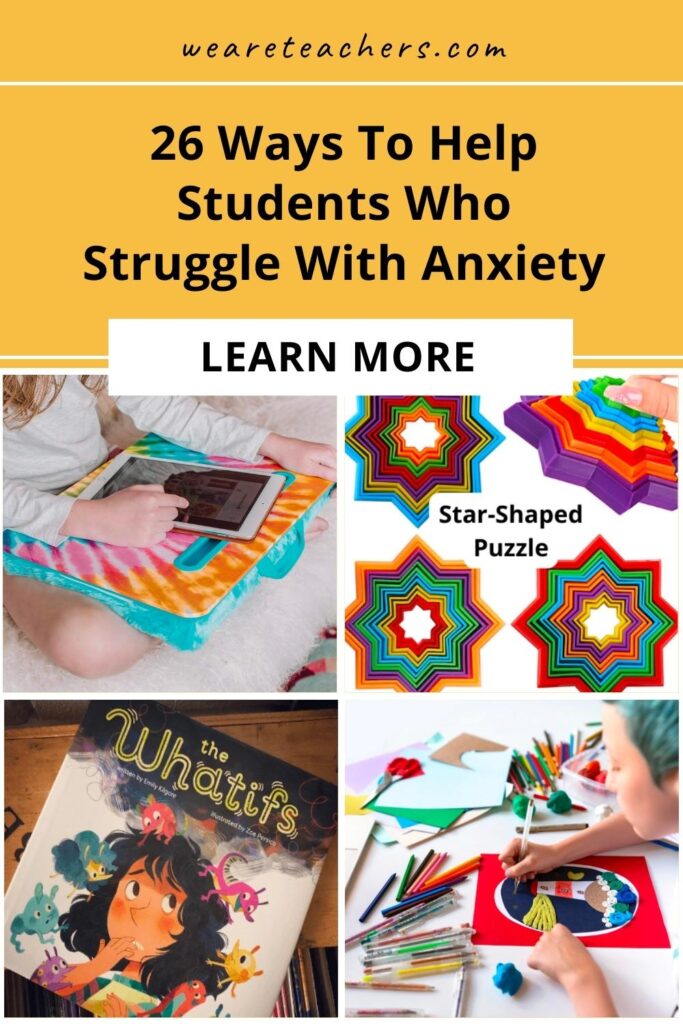Chances are you’ve seen a significant increase in the number of students who struggle with mental health over the past several years. According to JAMA Pediatrics, even before the pandemic, the rate of child and adolescent anxiety increased 27% between 2016 and 2019. By 2020, more than 5.6 million youths were diagnosed with anxiety. With symptoms such as trouble concentrating, an upset stomach, or sleeplessness, anxiety can be one of the most debilitating challenges students face in classrooms today.
We know anxiety is more than just “worries.” It can influence classroom performance just as much as any other learning disability. Kids who are worried and anxious aren’t doing it on purpose. The nervous system acts automatically, especially when it comes to worry (which often stems from fight-or-flight reflexes). That’s why phrases like “just relax” or “calm down” aren’t helpful. But with practice, kids can learn to slow down their anxious brains, and we can learn to help them. Here are a few ways you can help anxious kids in the classroom.
Anxiety Signs and Symptoms in Kids and Adolescents
- Poor concentration
- Insufficient sleep or frequent bad dreams
- Increased anger and irritability
- Frequent stomachaches or headaches
- Increased fidgeting
- Frequent toilet runs
- Clinginess
- Constant worrying
- Repetitive negative or unwanted thoughts
- Avoidance of social situations
- Low self-esteem
- Extreme fears
Ideas for Classroom Management and Culture
1. Educate yourself about anxiety
The more you understand about anxiety, the more you can arm yourself with strategies to help your students. This article from district superintendent Jon Konen provides a definition of anxiety, its causes, how to recognize it, types of anxiety disorders, and, most important, how you can help as a teacher.
2. Create strong bonds
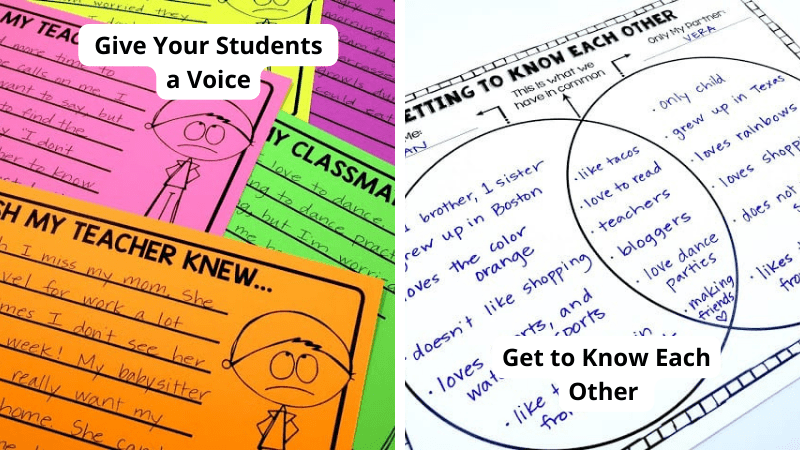
Building strong bonds and connecting to youth can protect their mental health. Schools and parents can create these protective relationships with students and help them grow into healthy adulthood. Try these Ways To Build Strong Classroom Community.
3. Talk openly about anxiety
Don’t set up anxiety as something you want (or should) get rid of. It’s part of life, and it’s not realistic to think it’ll go away completely. You can help students see and understand this in your own actions. Check out this article about what you should (and shouldn’t) do when working with kids dealing with anxiety.
4. Mind your classroom management
Schools play a critical role in helping students manage anxiety by creating environments where all students feel that they are cared for, supported, and belong. Certain classroom management approaches strengthen school connectedness. From teacher expectations and behavior management to student autonomy and empowerment, these strategies make a difference. Need some new ideas? Check out these brilliant classroom management strategies.
5. Validate students’ feelings
Before trying to problem-solve with students who are in the midst of racing thoughts or have completely shut down, Phyllis Fagell, a school counselor and therapist based in Maryland and Washington, D.C., recommends validating their feelings. For instance, saying, “If I was afraid I might look dumb, I’d be worried about raising my hand too,” may reduce the impact of anxiety and help a student relax, develop trust, and feel understood. Fagell also reminds teachers not to shame anxious students. For more, check out the full article from WGU about how to ease student anxiety.
6. Teach inclusivity
Poor mental health is a growing problem for children and adolescents. According to a JAMA Pediatrics meta-analysis of 29 studies including 80, 879 youths, the prevalence of depression and anxiety symptoms has significantly increased, remains high, and therefore warrants attention.
And some groups are affected more than others. In a report by the CDC, feelings of anxiety and depression were found to be more common among lesbian, gay, or bisexual students and female students. Almost half of lesbian, gay, or bisexual students and nearly one-third of students not sure of their sexual identity reported they had seriously considered suicide—far more than heterosexual students.
It’s essential that schools put serious effort into creating safe, inclusive classrooms and invest in curricula that supports equity. Here’s How To Make Your School a Safe Space for LGBTQ+ students. Plus check out these Tips for Facilitating a More Inclusive Classroom and Ways Social-Emotional Learning Can Help Your Class Become a More Inclusive Community.
Ideas To Encourage Healthy Lifestyles
7. Remind kids to eat healthily and stay well
For the most part, teachers don’t really have a lot of control over what students eat and how much they sleep, but these things do matter when it comes to managing anxiety. Not surprisingly, a healthy diet and plenty of sleep make a difference in how well a student is able to handle situations that could be overwhelming. It’s one of the reasons that snack time and rest time are an essential part of the day for preschoolers!
For your younger students, check out 17 tasty books that teach kids about nutrition and healthy eating habits for a list of picture books about healthy eating.
8. Encourage families to make sure their children are getting enough sleep
With all the extracurricular activities available to kids, not to mention the allure of high-stimulus technology, many kids are just not getting the amount of healthy sleep they need. According to the CDC, children ages 6-12 need as much as 9-12 hours of sleep each night. Preschoolers need even more (10-13 hours), and teens need between 8 and 10 hours. A solid night’s sleep does wonders for improving mood, concentration, and outlook. Good sleep quality is also essential. Encourage healthy sleep habits in your students with these Tips for Better Sleep.
9. Teach kids to recognize their warning signs
It can be difficult to figure out how to help kids with anxiety, but one surefire place to start is with identifying their warning signs. Everyone experiences anxiety differently. For children, signs may include shortness of breath, stomachaches, or inability to settle down and concentrate, among others. Coaching students to recognize their unique triggers and warning signs can help them know when to take a step back. Integrate social-emotional strategies throughout the day to help students learn to manage their anxiety.
Ideas To Create a Calm Classroom
10. Create a space where kids can express their anxiety
You’ve probably heard of classroom safe spaces or calm-down corners, and these are a great option to offer if you have students dealing with anxiety. They’re comfy zones in the classroom where kids can go to decompress and regroup. Many teachers include glitter jars, headphones, books, or other items to help kids get back on track. Here’s a list of ideas for your calm-down kit. For ideas to give your entire classroom a calming aesthetic, check out these calming classroom decor ideas.
11. Incorporate Zones of Regulation strategies
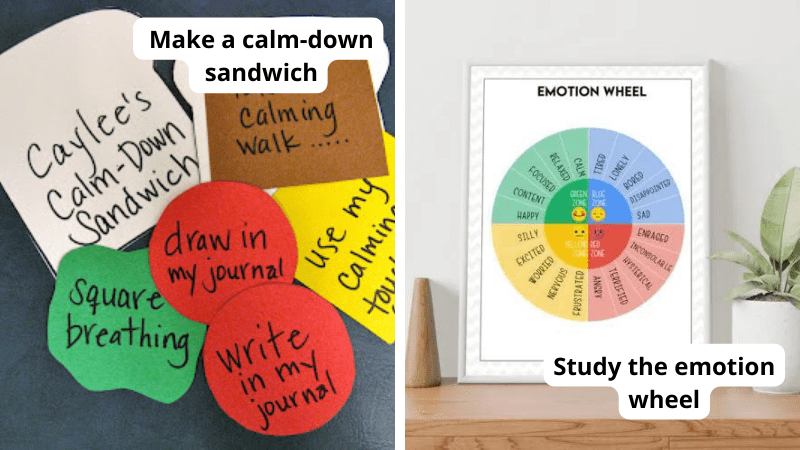
Students with anxiety need concrete, easy-to-use strategies to help them cope. Rooted in cognitive therapy, Zones of Regulation is a curriculum developed to help kids understand and learn to manage their emotions. Check out these Zones of Regulation activities for ideas.
12. Offer individual accommodations
For older students, accommodations can make all the difference. Many students struggle with performance anxiety, especially when it comes to tests. When a student is feeling anxious, their brain simply can’t function as effectively. When we can set up our tests and assignments so anxious kids are less stressed, they’ll likely perform better. Extended time and cue sheets could help kids who suffer from test anxiety. For other accommodations for kids who struggle with anxiety, check out this list from Worry Wise Kids.
The good news about anxiety is that it is one of the most manageable mental-health struggles that children face in the classroom. With the right support and strategies, most children are able to develop strategies that help them manage their anxiety.
The Child Mind Institute offers a “Symptom Checker” to help inform you about a student’s possible diagnoses and information and articles to help facilitate a conversation.
13. Try aromatherapy
Aromatherapy is thought to help activate certain receptors in the brain, potentially easing anxiety. Whether in the form of essential oil, incense, or a candle, natural scents like lavender, chamomile, and sandalwood can be very soothing. Check for sensitivities among your students before introducing a scent to the whole class. An alternative could be an unlit candle, dried herbs, or a sachet treated with essential oil kept in the classroom safe space for students to use individually.
14. Play calming music videos

Calming music has been shown to reduce the body’s stress response. When students are anxious, their bodies produce stress hormones like cortisol and adrenaline. Calming music can help lower the levels of these hormones, which leads to a sense of relaxation. Check out our favorite calming music videos for the classroom.
Tools To Promote Anxiety Relief
15. Tackle the topic with a good book
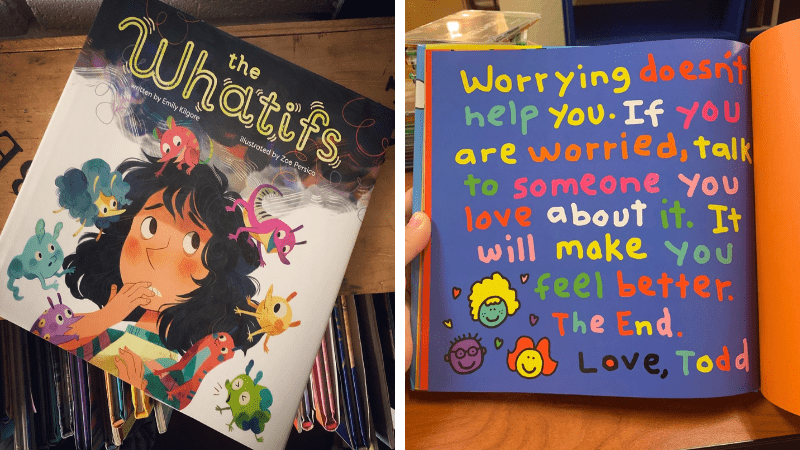
Often, when one of my kids is struggling, the school counselor will come and share a picture book about managing anxiety with the entire class. Some kids may not be receptive to direct, one-on-one intervention, but they will respond beautifully if they know the whole class is receiving the same information. Check out this list of great books for kids with anxiety.
16. Use fidgets

You have to get creative when figuring out how to help kindergartners with anxiety, since they are often too young for some methods. That said, there are certainly things that can help even the littlest learners self-regulate. One helpful idea, which can stand on its own or be part of your safe space, is offering students classroom fidgets. Sometimes this can work wonders in just giving kids an outlet for their amped-up energy. Here are our favorite classroom fidgets.
17. Try a weighted lap desk
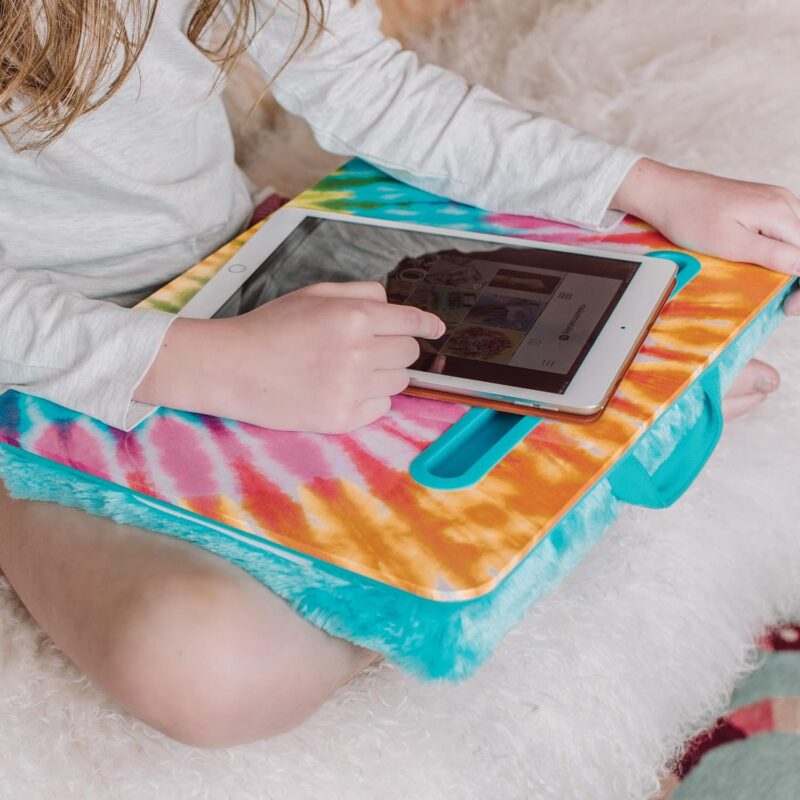
Weighted blankets and lap pads or desks can help turn off the fight-or-flight response. They can be a great tool to keep in your classroom or at home since they are portable and provide calming benefits for anxious children. While weighted items can be especially helpful for people with sensory-processing disorders, most people find them comforting. In addition to helping with self-regulation and concentration, they can also help fidgety kids sit still longer. Weighted lap desks, like this one from Amazon, are relatively affordable too!
Activities To Combat Anxiety
18. Practice those deep breaths
When people slow down their breathing, they slow down their brain. When I notice that one of my kids is struggling with anxiety, I’ll often lead the whole class in a breathing exercise. It helps the child who is overwhelmed and usually a few other kids too. Sometimes I’ll do it just because the whole class is squirrelly and we need to focus. Slow, deep breaths are the key. Check out this article, which includes a link to a printable that describes the process.
19. Take a break and go outside
Being out in nature can also calm an anxious brain. Sometimes just a change of scenery is what makes the difference. Breathing the cool air or making time to notice chirping birds can also calm an overactive worrier. Asking students to carefully observe their environment can help them turn the focus away from their worries and toward something more tangible: How many different kinds of trees do you see? How many different bird songs do you hear? How many different shades of green are in the grass?
It doesn’t hurt for us to take a mental break sometimes too. Check out these Terrific Guided Meditation for Teachers.
20. Create some art
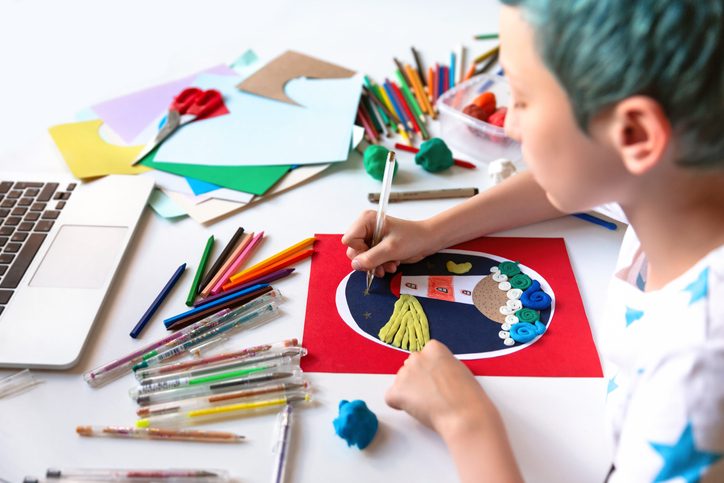
Regardless of whether you fancy yourself an artist, creating art can have numerous benefits. In addition to being fun, it can also help reduce anxiety by distracting our minds from racing or ruminating thoughts. Read more about the benefits of art therapy for anxiety. Then check out out these Easy Art Projects for Kids.
21. Get kids moving
Exercise helps anyone who is feeling anxious. Anxiety can end up looking like anger, so if you see this, try taking a movement break. You probably already have some favorite ways to do this, but if you’re looking for some ideas, check out our most popular brain breaks.
22. Try walking and talking
Building on the moving idea, if you have a student who needs some one-on-one attention, try the On My Walk activity. For many students who struggle with anxiety, after a couple of loops around the playground, everything feels a little better. The walks serve three purposes: 1. It removes the anxiety from the situation. 2. It gives the student a chance to explain the issue to an adult. 3. It gets the student’s blood pumping, which clears out the anxiety-producing energy and brings in the positive exercise endorphins.
23. Focus on the positive by having students keep a gratitude journal
The brain is incapable of producing anxious thoughts while it is producing positive thoughts stemming from gratitude. If you can trigger a positive train of thought, you can sometimes derail the anxiety. Have your students keep simple gratitude journals where they record at least one thing they’re thankful for every day. If you want to incorporate art, another anxiety-reducing activity, check out these creative bullet journal ideas. When your students seem overwhelmed by negativity or mired in anxiety, encourage them to reread their journals.
The video above has additional ideas from an inspiring teacher who incorporates gratitude into her classroom. Check out these meaningful gratitude activities and videos to help kids understand gratitude.
24. Play I Spy
Anxiety-coping skills for kids can come packaged in a fun way like a game. I Spy can help ground an anxious child since it encourages mindfulness. Focusing on the five senses helps pull attention away from racing or anxious thoughts. A variation like the one in this video will allow younger students to learn a coping skill while still having a lot of fun acting like their favorite animal. For more ideas, check out these Simple Mindfulness Activities for Kids and our favorite Apps To Help Combat Anxiety.
25. Count

The old adage of counting sheep to fall asleep is not just helpful because it bores you to sleep. The act of counting helps to stop racing thoughts and calm an anxious mind. Counting can be helpful in the classroom too! If a child is experiencing heightened anxiety, have them close their eyes or put their head down and then try one of these counting methods. You can have them count from 1 to 100 and then 2 to 100, and then 3 to 100, and so forth. Another option is to have them count backward from 100 (you can go lower for younger kids and higher for older kids). You can even have them try doing multiplication or division in their heads, assuming it is age appropriate.
26. Try tapping
Emotional freedom technique (EFT) tapping focuses on tapping the 12 meridian points of the body to help ease anxiety symptoms associated with a negative emotion or physical pain. Tapping is similar to acupuncture since they both focus on restoring the energy balance in the body. When practicing tapping with kids, there are a number of steps to follow, starting with identifying a problem. During the venting step, children will get out all their frustrations. During the reconciling step, they will make statements that offer solutions to the problem. These steps are done while tapping the meridian points as shown in the video above. Anxiety-coping skills for kids, like tapping, can help kids learn to self-regulate when facing a difficult emotion or problem. Once they have learned the basics, they can begin to practice it at home on their own.
Teachers also deal with anxiety. Here are some Ways Teachers Cope With Anxiety. Plus take a look at the realities of Sunday-night anxiety and what you can do about it.
And if you’re a school leader, check out What Principals Need To Know About Teacher Anxiety.
